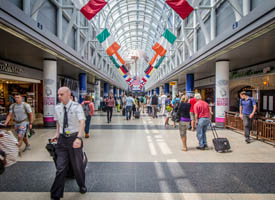- Details
 Two-time Emmy and Grammy award-winning comedian Kathy Griffin was born in Chicago on November 4, 1960. Griffin graduated from Oak Park River Forest High School and moved to Los Angeles with her parents shortly after.
Two-time Emmy and Grammy award-winning comedian Kathy Griffin was born in Chicago on November 4, 1960. Griffin graduated from Oak Park River Forest High School and moved to Los Angeles with her parents shortly after.
Griffin has a regular stand-up engagement at the Laugh Factory in Los Angeles and hosted the reality series “Average Joe” in 2003. Griffin also stars in the self-titled reality series “Kathy Griffin: My Life on the D-List”.
Learn more:
Read more about the life of Kathy Griffin
Visit the official site of Kathy Griffin
- Details
 Popular candy bars Baby Ruth and Butterfinger were both created in Illinois by Otto Schnering, who founded the successful Curtiss Candy Company near Chicago in 1916.
Popular candy bars Baby Ruth and Butterfinger were both created in Illinois by Otto Schnering, who founded the successful Curtiss Candy Company near Chicago in 1916.
Curtiss Candy Company created the Baby Ruth bar in 1921 and the Butterfinger in 1923. After the Baby Ruth bar was introduced, most at the time assumed the candy bar was named after George “Babe” Ruth, then a player for the New York Yankees. The Curtiss Company claimed the bar was named after President Grover Cleveland’s daughter Ruth Cleveland.
Nestlé bought the rights to both Baby Ruth and Butterfinger and operates manufacturing facilities in Franklin Park.
Learn more:
Hungry History – Babe Ruth v. Baby Ruth (History.com)
Otto Schnering
Baby Ruth
Butterfingers
- Details
 “It takes different strokes to move the world, yes it does. It takes different strokes to move the world.”
“It takes different strokes to move the world, yes it does. It takes different strokes to move the world.”
That line sound familiar? That’s because it’s from the timeless television show, “Diff’rent Strokes,” which debuted on this day in 1978 and starred Gary Coleman, who was born in Zion, Illinois.
Coleman was born on February 8, 1968 and was adopted soon after birth. He was born with a congenital kidney disease which stunted his growth. Coleman would never grow to be taller than 4 feet 8 inches because of his birth defect.
When Coleman was 9 years old, he was discovered by a talent agent and started doing small roles that put his image out there to other producers. In 1978, he made his big breakthrough on the show “Diff’rent Strokes,” where he played an African-American orphan who was taken in by a wealthy white father and his daughter. People all over the world know his famous phrase, “What’choo talkin’ bout, Willis?”
When the show ended, Coleman appeared in the films “On the Right Track” and “The Kid with the Broken Halo,” which later turned into the cartoon series “The Gary Coleman Show.” When Coleman was 10 years old he decided to form his own company, Gary Coleman Productions.
Coleman also appeared on “Fresh Prince of Bel Air,” “Married with Children” and “The Keenen Ivory Wayans Show.”
Learn more:
Read more about the life of Gary Coleman on IMDb
- Details
 Singer, songwriter, artist and model Grace Slick was born in Highland Park on October 30, 1939. After graduating from high school, Slick attended Finch College and the University of Miami in Florida.
Singer, songwriter, artist and model Grace Slick was born in Highland Park on October 30, 1939. After graduating from high school, Slick attended Finch College and the University of Miami in Florida.
Her musical career began in 1964 in San Francisco after The Great Society was created with the help of her husband Jerry Slick and his brother Darby Slick. By 1965, the band was recording and had released a single, but in autumn of 1966, Grace left the band to join Jefferson Airplane as their lead singer.
The band went on to release “White Rabbit” and “Somebody to Love,” and both were placed on the “Rolling Stones” top 500 greatest songs of all time. After eight years together, the band split up, but Slick eventually reconvened with some of the band members and created Jefferson Starship. Together Jefferson Starship released a number of successful albums, and the “Dreams” album received a Grammy nomination.
Since retiring from music, Slick has followed her love of art and animals by painting on a full time basis, and many of the pieces she has created are available for purchase.
Learn more:
Read more about the life of Grace Slick
- Details
 The world’s busiest airport in 2014 first opened on this day in 1955. Named after Edward “Butch” O’Hare, a World War II pilot who received the Congressional Medal of Honor for his heroism, the airport was originally an Air Force base and manufacturing center for military aircraft. Once commercial flights began taking off, operations at nearby Midway Airport, once the world’s busiest in its own right, began to decrease. Midway would eventually go through a series of renovations and become a secondary reliever airport for the region.
The world’s busiest airport in 2014 first opened on this day in 1955. Named after Edward “Butch” O’Hare, a World War II pilot who received the Congressional Medal of Honor for his heroism, the airport was originally an Air Force base and manufacturing center for military aircraft. Once commercial flights began taking off, operations at nearby Midway Airport, once the world’s busiest in its own right, began to decrease. Midway would eventually go through a series of renovations and become a secondary reliever airport for the region.
Today, O’Hare is a major hub for Chicago-based United Airlines as well as American Airlines and Air Choice One. The airport offers direct service to 210 destinations with an average of 2,400 flights per day.
Learn more:
Read more about the recent opening of a new runway and control tower at O’Hare
More Articles …
- Did You Know? Illinois county number one in popcorn production
- Did You Know? Astronaut Steven Nagel was from Illinois
- Did You Know? Illinois hosts one of six World Marathon Majors
- Did You Know? Illinois leads the nation in pumpkin production
- Did You Know? Illinois is home to the Pullman National Monument





